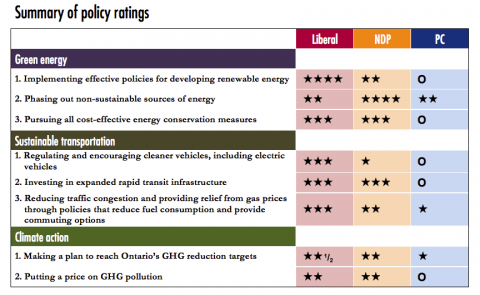TORONTO — New analysis of the election promises made by Ontario's main political parties has identified clear leaders in building the province's clean energy economy.
A detailed platform analysis released today by the Pembina Institute, a national non-partisan sustainable energy think tank, compares the commitments the Ontario Liberal, NDP and Progressive Conservative parties have made on a range of sustainable energy priorities. The analysis looks at where the parties stand on issues such as investing in renewable power generation, reducing greenhouse gas emissions, creating incentives for energy conservation and expanding transit systems.
"Each party has plans in its platform to keep our lights on and build transportation infrastructure," says Cherise Burda, director of Ontario policy for the Pembina Institute. "But when it comes to building a clean energy future for Ontario, the Liberals and NDP are far ahead of the Progressive Conservatives."
Overview of rankings
The parties were ranked according to how their commitments aligned with the policies recommended by the Pembina Institute, prior to the election. Those recommendations aim to ensure Ontario's transition toward a clean and sustainable energy system continues. (Note: For a more detailed breakdown of the parties' rankings, please see the background section below, or download the full analysis.)
The key policies that lead to high scores were maintaining the province's feed-in tariff for renewable energy, ensuring that transportation policies would deliver a reduction in fuel consumption and greenhouse gas emissions, and developing a credible plan to meet Ontario's climate commitments.
"Ontario's Green Energy Act is modeled off the most successful renewable energy policies in Europe - policies that create the long-term market stability necessary to attract continued investment and create jobs," said Tim Weis, director of the Pembina Institute's renewable energy program. "Already, some of the parties' proposals are introducing significant market uncertainty, since they could re-write or even eliminate the rules that have attracted recent investments. Market uncertainty could put the future of Ontario's green electricity economy in jeopardy, and risk undermining the province's role as a North American leader in this growing global industry."
-30-
The Pembina Institute's full Ontario platform comparison is available online.
Contact:
Cherise Burda
Director, Ontario policy
Cell: 416-824-0256
Background:
For full details about the Pembina Institute's policy recommendations, ranking criteria, and the comparison of Ontario party positions, please see our detailed platform analysis.
Some highlights of the platform analysis are outlined below.
Parties' positions on clean energy
The Liberals and the NDP lead neck-and-neck on electricity and conservation commitments, but their approaches are significantly different.
All three parties would continue the current progress towards phasing out coal-fired electricity by 2014. The NDP has also committed to not building any new nuclear reactors. The Liberals would continue their commitment to the province's feed-in tariff mechanism for renewable energy. The NDP would scale-back the feed-in tariff program to apply to community projects only, and would entirely re-write how larger projects are developed by increasing Ontario Power Generation's role as a Crown corporation. The PCs have committed to repealing the Green Energy Act and canceling the feed-in tariff entirely.
Parties' positions on clean transportation
Given that driving is the primary means of transportation for most Ontarians, and considering the high volume of fuel the province imports for transportation, encouraging the production and purchase of more fuel-efficient and electric vehicles should be a priority for all parties. Only the Liberal party, however, has stated plans to invest in electric vehicle infrastructure and incentives.
All parties except for the Progressive Conservatives plan to stay the course on the Metrolinx Big Move transit plan introduced by the current Liberal government. Modelling by the Pembina Institute shows that this policy is the single most effective tool to reduce pollution and oil consumption from Ontario's transportation sector.
The NDP ranked higher for offering relief to municipalities by funding half of municipal transit operations, as do the Liberals for their promise to improve GO train service and build rapid transit outside of the Greater Toronto Area. The PC party, however, would take Ontario in the opposite direction, by redirecting scarce transit funds to building roads and highways.
The NDP's commitments on transportation would move Ontario forward in some areas, while reversing progress in other areas. The party's commitment to freeze transit fares is positive, as is the plan to invest in cycling safety and infrastructure. But the NDP has also committed to subsidize driving by reducing the HST on gasoline and giving gas breaks to northern drivers, rather than cutting the cost of driving by supporting incentives for more fuel-efficient vehicles and other measure to reduce fuel use.
Parties' positions on addressing climate change
Both the Liberals and the NDP commit to move forward with a cap-and-trade program and put a price on carbon emissions, while there are no climate commitments in the PC platform.





